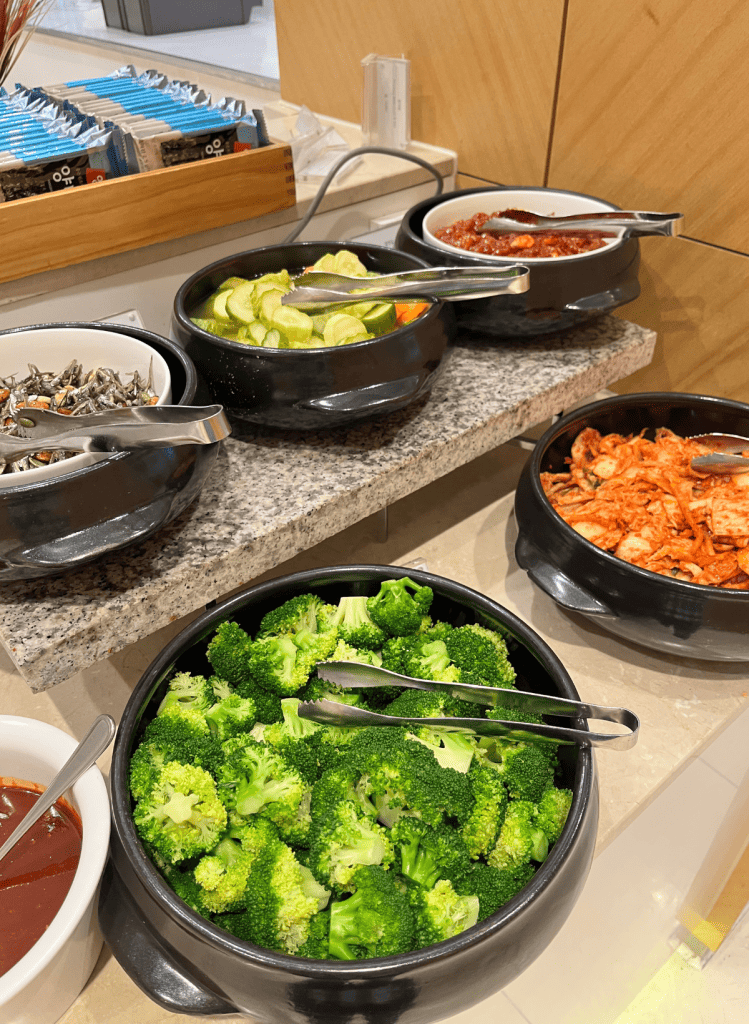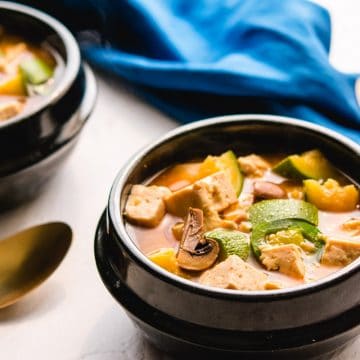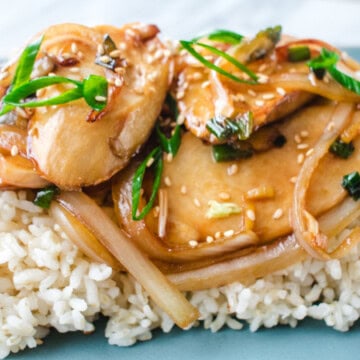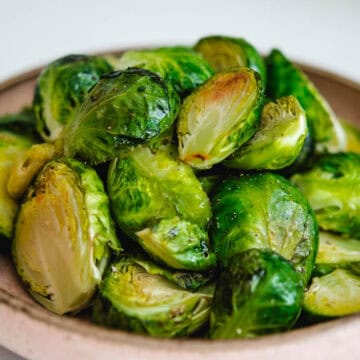That little dish of broccoli florets served at Korean restaurants is so easy to replicate at home. A touch of garlic and sesame flavor make this a versatile side dish that you can serve hot, cold or at room temperature and with practically anything.

This is a goes with anything, jack of all spades, easy accompaniment with a vegetable that is available year round and practically everywhere.
Looking for other Korean vegetable side dishes? This is a lot like Korean sesame spinach, 5 minute bean sprouts, and or try Korean fern brake for something a little more unusual.
Jump to:
Why You'll Like this Recipe
- Yet another way for broccoli to appear on the table. It goes with everything. You can serve this with all types of cuisine, not just a Korean themed one.
- Make it ahead of time. Store in the fridge up to 3 days.
- Serve hot, cold, or at room temperature.
Ingredients

- Broccoli - You could either buy a whole head of broccoli and cut them into florets, or buy a bag of florets already cut up.
- Toasted Sesame Oil - Most sesame oil is toasted, resulting in a dark brown color. However, some sesame oil is not toasted and has a clear, yellowish color similar to other vegetable oils. Toasted sesame oil is the not so secret seasoning weapon in so many Asian cuisines, including Korean. It adds nuttiness, sesame flavor and fragrance. A little bit goes a long way.
- Garlic - It wouldn't be Korean without the addition of fresh, pungent garlic. A mandatory ingredient in kimchi and most Korean vegetable dishes. Garlic really provides an earthy balance so green vegetables don't taste so much like rabbit food.
- Salt - This can be added to the broccoli after it's cooked or used to season the water it's cooked in.
See recipe card for quantities.
Optional Seasoning Ingredients
Some people like adding these things to this broccoli salad. You might use them based on what else you're serving that day.
- Rice vinegar - Pro: It adds sourness and an acidic punch to brighten up that strong broccoli flavor. Con: It also discolors the broccoli and makes it turn yellow the next day. Verdict: Use it on the portion of broccoli you plan to consume the same day. Rice vinegar is very mild in sourness, but you could substitute with apple cider vinegar or other lightly color vinegar.
- Sugar - Accentuates the sweetness in the broccoli. Sugar does make many foods taste good. I put it as optional because there's sugar in everything, and one benefit of cooking at home is controlling what goes into your food.
- Toasted sesame seeds - So tiny, yet so powerful. You wouldn't think so, but sprinkling these on top of the broccoli (or anything else for that matter) really gives it a little extra nutty bite.
- Black Pepper - While white pepper is commonly used in Chinese and French cuisines, black pepper is the preferred choice in Korean cuisine. Some chefs add it to everything (like salt). Some chefs use it sparingly and only when that peppery flavor is desired. Use if you like black pepper!
Why there are so many optional ingredients? In an effort to make the ingredient list as simple and doable as possible, the mandatory ingredients are listed as part of the recipe. The optional ingredients aren't absolutely necessary to capture the essence of the dish.
Instructions
Instructions are provided here for the standard method of boiling in water, like my mom would do, before Instant Pots were around. I believe you could steam the broccoli in the Instant Pot for 1-2 minutes until al dente, but I haven't tried that method myself.

Cut the broccoli into florets. Restaurants seem to cut them into 2x2"pieces. Cut as uniformly as possible, so they cook at the same rate. Meanwhile bring a pot of water to the boil as you chop.

Drop the broccoli into the boiling water. Let water return to a boil, and cook for 1-3 minutes until the broccoli is tender but not mushy and still has a little bit of bite.

Drain the broccoli. If serving this dish cold or at room temperature, shock the broccoli ice water for a few minutes. This helps the broccoli retain its bright green color. Drain the broccoli from the ice water.

Mix the dressing ingredients in a large bowl large enough to hold the broccoli. Add the broccoli and toss well. Check for seasoning and add more salt as needed.
Hint: In Western restaurants, you would always salt the boiling water whenever you're cooking green vegetables. Salt cooks into the food rather than being seasoned with it after cooking. However, in Asian cuisines, salt often doesn't come in the form of salt granules. It's comes in the form of soy sauce, fish sauce, miso paste, etc. It's served at the table in little condiment jars and bowl of pickles.
All this to say that a great way to season the broccoli is to add salt to the boiling water. But the 'authentic' Korean way would be to boil in unsalted water and season after. (My mom never added salt to the water.)
Substitutions
You could really make this recipe with any green vegetable of your choice.
- Other Green Vegetables - such as green beans, sugar snap peas, or edamame pods.
- Garllc Powder - If you don't love a pungent hit of raw garlic, substitute with garlic powder for a more mild garlic flavor.
Variations
There are a few ways you could mix up this simple recipe.
- Roasted Garlic - Another nice way to add a really nice garlicky flavor is to use roasted garlic instead of raw garlic.
- Spicy - Sprinkle in some Korean chili flakes (gochugaru) or pepperoncini red pepper flakes.
- Naked - Instead of adding a dressing to the broccoli, serve the broccoli plain with a side of Korean gochujang sauce. (This is my mom's preferred method for serving broccoli.)
- Steam - If you have a steamer basket, steaming the broccoli instead of boiling in water allows for the best retention of chlorophyll, Vitamin C, and other nutrients according to this article published by the Journal of Zhejiang University.
The combination of green vegetables with a nutty element is also featured in this similar easy recipe for green beans with walnuts.
Korean broccoli in the wild

Equipment
No special equipment is required. Just a pot large enough to hold the broccoli with room to spare. The broccoli shouldn't be too crowded in the pot, so it has ample space to move around and cook evenly in the boiling water.
You'll aslo need a mixing bowl large enough to toss the broccoli with the dressing.
Storage
Store up to 3 days in the fridge.
Not recommended for freezing, since it makes the broccoli soggy.
Top tips
- Don't overcook the broccoli! Does anyone enjoy eating mushy, swamp green broccoli The broccoli cooks quickly, so just a couple minutes in boiling water. You should be able to pierce it with a fork or paring knife fairly easily, but the easier it is the more cooked it is. You still want it to have some crispy texture.
- Broccoli stems are edible. You don't have to throw away that tree like trunk of broccoli underneath the crown. Just peel the tough outer layer with a vegetable peeler. Cut into chunks a little bit smaller than the florets, since they take a little longer to cook.
- Salt the boiling water if you really want to penetrate the salt into the broccoli and have a more seasoned tasting broccoli. Otherwise, the more traditional method is to cook in unsalted water, and season with salt after it's cooked.
- Steam instead of boiling in water if you'd like maximum nutrient retention in your broccoli.
More Plant Based Recipes
Looking for other recipes like this? Try these:
Pair with Korean Dishes
These are some favorite Korean dishes to serve with broccoli salad:
Recipe
Easy Korean Broccoli Side Dish
Ingredients
- 1 lb broccoli, cut into florets roughly 2" pieces about 6 cups
Dressing
- 2 Tb toasted sesame oil
- 1 clove garlic minced
- ½ teaspoon salt
Optional Ingredients
- ¼ teaspoon sugar
- 1 Tb unseasoned rice vinegar
- 1 tsp toasted sesame seeds
- ¼ teaspoon black pepper
Instructions
- In a pot large enough to hold the broccoli, fill with water and put on high heat and bring to a boil. The water should cover the broccoli with at least 2 inches to spare of additional water.
- Add the broccoli. The water may stop boiling. Leave on high heat and allow to return to a boil. Once the water returns to a boil, cook for 1-3 minutes until the broccoli is crisp tender.
- Strain the broccoli into a colander. If you want to serve the broccoli cold or at room temperature, put broccoli into a bowl of ice water to stop cooking. This helps keep the color of the broccoli bright green. Leave for about 5 minutes, then drain from the ice water.
- Mis the dressing ingredients together in a bowl large enough to hold the broccoli. Toss with the drained broccoli.
- Serve immediately or store in the fridge for up to 3 days.
Notes
- Don't overcook the broccoli! Does anyone enjoy eating mushy, swamp green broccoli The broccoli cooks quickly, so just a couple minutes in boiling water. You should be able to pierce it with a fork or paring knife fairly easily, but the easier it is the more cooked it is. You still want it to have some crispy texture.
- Broccoli stems are edible. You don't have to throw away that tree like trunk of broccoli underneath the crown. Just peel the tough outer layer with a vegetable peeler. Cut into chunks a little bit smaller than the florets, since they take a little longer to cook.
- Salt the boiling water if you really want to penetrate the salt into the broccoli and have a more seasoned tasting broccoli. Otherwise, the more traditional method is to cook in unsalted water, and season with salt after it's cooked.
- Steam instead of boiling in water if you'd like maximum nutrient retention in your broccoli.
Nutrition
Food safety
- Do not use the same utensils on cooked food, that previously touched raw meat.
- Don't leave food sitting out at room temperature for extended periods.
- Never leave cooking food unattended.
- Use oils with high smoking point to avoid harmful compounds.
- Always have good ventilation when using a gas stove.
See more guidelines at USDA.gov.
Fortune Cookie 🥠
You have brains in your head. You have feet in your shoes. You can steer yourself any direction you choose.
Dr. Seuss
Lucky Cat 🍀 🐈



























Leave a Reply